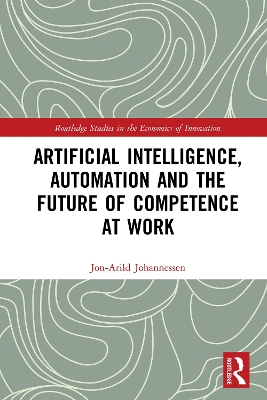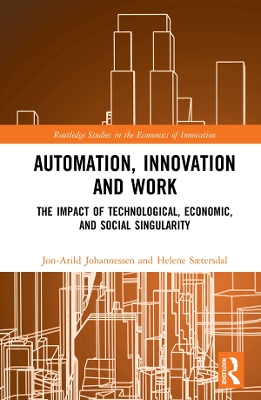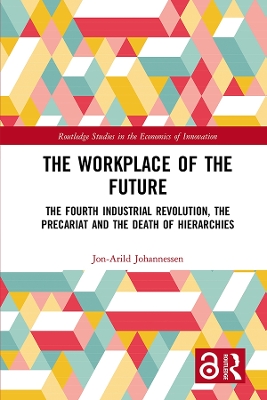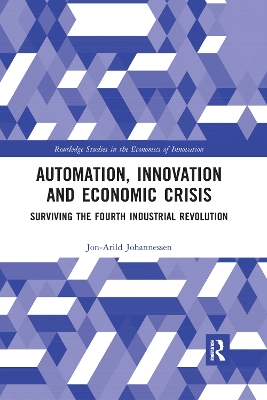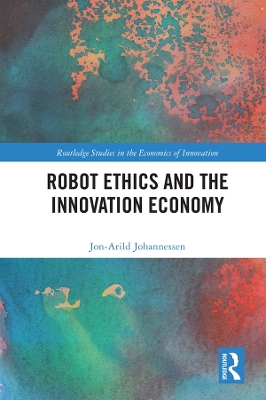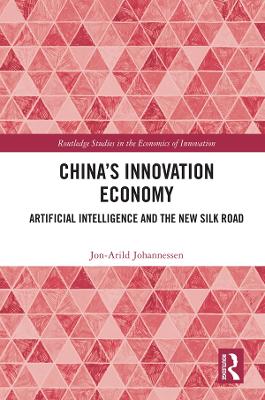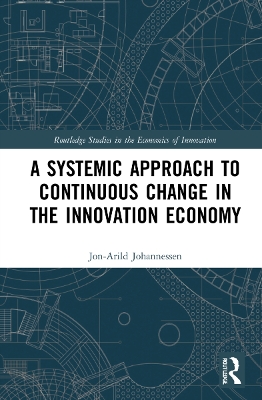Routledge Studies in the Economics of Innovation
11 total works
Artificial Intelligence, Automation and the Future of Competence at Work
by Jon-Arild Johannessen
Artificial intelligence and the autonomous robots of the Fourth Industrial Revolution will render certain jobs and competences obsolete but will also create new roles, which in turn require new sets of skills. They will also transform how we produce, distribute and consume, as well as how we think. Rather than a linear understanding of evolutionary processes, we will develop a more interactive and circular interpretation.
This book offers a unique and holistic perspective on the future of work in the context of industry 4.0. It discusses the globalization of capital markets, how artificial intelligence can help organizations to be more competitive and the new role of leadership in this technological landscape.
The author argues that there are four categories of competences, which will be required in order to maintain the relevance of human skills and expertise in the innovation economy. The new jobs that come into being will lend themselves to a particular set of skills. General competences will be necessary for roles involving the 4Cs of communication, creativity, collaboration and change. Specific or STEM competences will be called for across the science, technology, engineering and mathematics sectors. Human competences will lend themselves to positions comprising the SELC framework of social, emotional, leadership and cultural skills. Critical or REVE competences will be in demand for roles embracing reflection, ethics, values and the environment.
The book provides a human-centric view of the current technological advancements of artificial intelligence and robotics and offers a positive outlook for human actors seeking continued relevance. It will appeal to scholars and students of the innovation economy, the knowledge society and the coming Fourth Industrial Revolution.
Automation, Innovation and Work
by Jon-Arild Johannessen and Helene Saetersdal
Artificial intelligence will not necessarily create a super-intelligent “human robot”; however, it is very probable that intelligent robots and intelligent informats will bring about a form of super-globalization, in which money and goods are prioritized over people and democracy and where the widespread use of casual labour – that is, short-term contracts – will become the most common form of employment relationship. It is also very likely that artificial intelligence will bring about what is known as singularity. This term is used to describe a situation where intelligent robots, from a rational and logical perspective, are smarter than humans, i.e. the development of AI.
This book explores the impact that these intelligent robots and intelligent informats will have on social and societal development. The author tackles the question of singularity from three distinct standpoints: technological singularity – the intelligence of machines compared to that of humans – which he argues will bring about a qualitatively new labour market; economic singularity – the consequences for work relationships, value creation and employment – which he asserts will promote full automation, result in precarious contracts with low salaries, and, in some countries, possibly lead to the introduction of a universal basic income; and social singularity – the consequences of technological and economic singularity for democratic processes, bureaucratic procedures for exercising authority and control, and the direction in which society will develop, in addition to the emergence of new social institutions – which Johannessen says will promote a transition from representative democracy to genuine democracy.
The book will appeal to academics, researchers and students of economic sociology and political economy, as well as those focusing upon the emerging innovation economy. It will also find an audience among professionals and policymakers keen to understand the impact the Fourth Industrial Revolution will have on organizations, individuals and society at large.
The Fourth Industrial Revolution is a global development that shows no signs of slowing down. In his book, The Workplace of the Future: The Fourth Industrial Revolution, the Precariat and the Death of Hierarchies, Jon-Arild Johannessen sets a chilling vision of how robots and artificial intelligence will completely disrupt and transform working life.
The author contests that once the dust has settled from the Fourth Industrial Revolution, workplaces and professions will be unrecognizable and we will see the rise of a new social class: the precariat. We will live side by side with the 'working poor' – people who have several jobs, but still can’t make ends meet. There will be a small salaried elite consisting of innovation and knowledge workers. Slightly further into the future, there will be a major transformation in professional environments. Johannessen also presents a typology for the precariat, the uncertain work that is created and develops a framework for the working poor, as well as for future innovation and knowledge workers, and sets out a new structure for the social hierarchy.
A fascinating and thought-provoking insight into the impact of the Fourth Industrial Revolution, The Workplace of the Future will be of interest to professionals and academics alike. The book is particularly suited to academic courses in management, economy, political science and social sciences.
The fourth industrial revolution is developing globally, with no geographical centre. It is also taking place at enormous speed. This development will shape the workplaces of the future, which will be entirely different from the workplaces created by the first, second and third industrial revolutions. Industry created the industrial worker. The knowledge society will create a new type of "industrial worker", the knowledge worker. While the third industrial revolution was concerned with the digitalization of work, in the fourth industrial revolution, robots will bring about the informatization of work. Many of these robots will be systematically connected, such that they can obtain updated information and learn from their own and others’ mistakes. The way we work, where we work, what we work on, and our relationships with our colleagues and employers are all in a state of change. The workplace of the future will not necessarily be a fixed geographical location, but may be geographically distributed and functionally divided.
In his book, Jon-Arild Johannessen argues that a "perfect" social storm occurs when inequality grows at a catastrophic rate, unemployment increases, job security is threatened for a growing number and robotization takes over even the most underpaid jobs. Thus, the ingredients for a perfect social storm will be brought forward by cascades of innovations that will most likely lead to economic and social crises and he argues that it is reasonable to assume that it will only take a small spark for this social storm to develop into a social revolution.
This book provides an authoritative resource on the topic of intelligent robots, artificial intelligence and the ethical implications of these revolutionary innovations. It examines the moral and ethical problems that arise in relation to the development, design and use of intelligent robots, which are capable of autonomous or semi-autonomous decision-making. These problems might relate, for example, to medical robots, driverless cars, intelligent military drones, pedagogical robots, police robots, legal robots and many others.
The main question addressed in this book is how we can understand, explain and apply the concept of ethics in relation to intelligent robots and artificial intelligence. In each chapter, the author examines a different aspect of this question. The author also questions how we can ensure that intelligent robots are of service to humans and under what conditions intelligent robots could become more ethical than humans. The book employs an original approach to examining this cutting-edge research question, combining different research areas, and offers a wealth of practical relevance and real-world examples, illustrated through vivid case studies. With its jargon free approach and a dedicated chapter on relevant concepts at the end, this book is also accessible to readers without prior knowledge on intelligent robots and the Fourth Industrial Revolution.
By providing a general account of this debate, and of the consequences of the innovations resulting from these trends, the book serves as an important contribution to the discussion and will find a natural readership among scholars and students of the innovation economy and those concerned with the ethical considerations arising in the wake of the Fourth Industrial Revolution
Two trends will have more influence than anything else on the world's future political and economic situation: the development of artificial intelligence and the emergence of China as a competitor to the United States on the international stage.
This book is about the emerging innovation economy. It uses systems theory and evolutionary economics as a theoretical point of departure and explains why the focal point of the geopolitical stage is moving away from the alliance between the United States and Europe, and towards an alliance between China, the 14 Regional Comprehensive Economic Partnership countries, the countries along the new silk road, and Europe.
The book argues that the globalization strategy of neoliberalism laid the foundation for the Chinese economic engine. Whereas the old globalization was driven by cost differences generally, and wage costs specifically, the new globalization is driven by divergence in competence in general, and technological competence in particular, and China's primary goal is to develop artificial intelligence and intelligent robots. Further, the book posits that the interactions between the climate crisis and the new technology will change production, distribution and the creation of profits, both in China and more widely in the global innovation economy. The book develops a structure to describe, analyze and explain the Chinese innovation economy and contributes to the discussion regarding technological developments in China.
The book is written for readers who are oriented towards the new globalization that is emerging in the innovation economy and the factors driving China's economic growth.
A Systemic Approach to Continuous Change in the Innovation Economy
by Jon-Arild Johannessen
Unpredictable and unforeseen, or black swan, events are occurring increasingly often, one such recent example is the coronavirus crisis of 2020. The Fourth Industrial Revolution, with its growing use of artificial intelligence, intelligent robots, intelligent informats and intelligent algorithms, may help us to confront these incidents but only if we can avoid the sector optimization logic of some forms of economic thinking.
This book offers a multi-faceted presentation of the application of systemic thinking in non-standard situations, especially those created by the fourth industrial revolution. It develops models and mini theories to promote systemic thinking at a time when cascades of innovations are entering the economy, while at the same time black swan events are occurring and disrupting social systems. It takes a critical look at how organizations and social systems have chosen to organize themselves to develop systems that prioritize high performance, by focusing on cost-cutting and maximizing profits, instead of on preparedness elasticity and resource slack. The consequences of this kind of organizational streamlining becomes evident only when the ‘black swans’ loom.
The author discusses how individuals and society can develop the resilience needed to deal with these incidents. He asserts that there are three central social mechanisms that can help us understand how social systems work and how they are interconnected: time-lag, threshold value, and feedback. These three concepts can help us to understand how changes occur in non-linear systems; for instance, how small changes at the micro level can lead to large changes at the macro level.
This book will be of interest to researchers, academics and students in the fields of economics, finance, business and industry.
In feudal society, it was the few at the top who laid the ground for what was produced, how it was produced and how it was distributed. Freedom was restricted, and people were kept in their place by institutional structures. In capitalism, the focus is on free markets, free trade, and a personal freedom, where self-interest is assumed to lead to progress for the collective good. In today’s world, there is a move towards algorithmic capitalism at the micro-level, platform capitalism at the meso-level, and feudal capitalism at the macro-level. This is the new and innovative concept developed in this book.
The author argues that feudal capitalism is distinct but linked to the innovation economy, and represents an interconnection between the organization of feudal society and central aspects of capitalism. Additionally, he asserts that the balance between feudal capitalism and a reinvented, sustainable capitalism based on the innovation economy, can help restore the moral compass lost in the evolution of global capitalism.
The key argument of the book is that even if we see a development towards feudal capitalism, a more just and moral capitalism can be restored through various social mechanisms such as changes in the institutional framework, the development of a balanced form of globalization and re-establishing social cohesion and equality of opportunity. Further, the book offers policy interventions to support this idea.
The book will find an audience among scholars and researchers of political economy, political theory, economic history, management, AI and ethics, philosophy and automation, inequality and equality of opportunity
The New Silk Road and the Innovation Economy in China
by Jon-Arild Johannessen
This book provides deep insight into the emergent Chinese innovation economy, as we head towards the Fourth Industrial Revolution. It describes, discusses and analyzes the period from China’s opening up to foreign investment in the 1980s until the New Silk Road project, from 2013 onwards. The developments are assessed from a systemic thinking and evolutionary economic standpoint.
The book presents the latest research findings on the direction and achievements of the Belt and Road Initiative, and the results both for China, the countries along the new Silk Road, as well as for Europe and the United States are brought to light. The author asserts that the phenomenon of the New Silk Road as an innovation generator can be understood and explained through the effects of various social mechanisms. He labels these five social mechanisms as: the locomotive force; the explosive force of the butterfly effect; the force of co-creation; the force of expectation; and the force of competence.
The book presents 20 cases to substantiate the descriptions, analysis, theoretical reflections and the practical utility of the questions examined in each chapter. It utilizes economic history research methods, scenario thinking, futures research and conceptual generalization to offer different views on the research problem under investigation. Further, the book offers policy suggestions, which include promoting effective macroeconomic policies, and extending microeconomic cooperation schemes, related to the innovation economy.
The book will appeal to academics, researchers and graduate students concerned with Chinese economic expansion, Chinese foreign policy and US- and Europe-China relations, as well as policymakers and political advisors.
The Fourth Industrial Revolution and the Labour Market
by Jon-Arild Johannessen
The innovation economy is the driver for the development of the Fourth Industrial Revolution and consequently, there is a growing focus on innovation in general and technological innovation in particular. In this context, there is much to suggest that it is the triple impact of artificial intelligence, big data and 5G- and 6G networks that will go beyond the limits of existing competence.
This book is about the new competence that is emerging in the wake of artificial intelligence and intelligent robots. It explains how these two technologies are completely fundamental to what is known as the Fourth Industrial Revolution. The author argues that artificial intelligence will promote automation, which will reduce wages rather than increase unemployment statistics. The book posits that when the utility value of technology and the rate of dissemination of technology is high, people who have the necessary competence will both future-proof their jobs in the labour market and also be among the highest-paid workers in the new economy that is emerging from the innovation economy. Further, by making education more compatible with new technology will enable graduates to access more secure and better paid jobs, and all behavioural fields related to new technology will flourish because they can be used in many contexts to steer people’s behaviour in certain directions through the integration of big data and artificial intelligence.
The book employs the following scholarly methods: conceptual generalization, scenario-based thinking and historical economic methodology, thus it will be of particular benefit to academic scholars, researchers and graduate students who are concerned with the impact of the fourth industrial revolution on the labour market.
Cascades of new technologies and innovations are entering our lives so fast that it is difficult for us to adapt to one innovation before the next becomes embedded into our everyday lives. What happens when the changes brought by technology are so profound that they affect all aspects of our lives? This book explores the potential impact of artificial intelligence (AI) and intelligent robots on individuals, organizations and society, specifically examining the impact on jobs and workplaces in the future. It provides an understanding of how we can adapt to changes that appear like flocks of black swans.
Five key areas are unpacked in the book: automation, AI, (the significance of AI technology), innovation, competence transformation, and the fact that the pace of change is so rapid that it outstrips our ability to adapt to consecutive changes. The main objective is to show how artificial intelligence will change society, and how we as individuals and society must adapt in order to survive what the author terms ‘robot shock’, together with its consequences and after-effects. It offers a greater understanding of resistance to change, and how we need to adopt strategies for adapting to major changes. Each of the book’s six chapters also contains policy inputs, framed as propositions, that are intended specifically for decision-makers. The book ends by offering possible strategies for overcoming the negative effects of ‘robot shock’.
The book intends to send a message to leaders of institutions, decision-makers and anyone attempting to understand and explain how we – as a social system – can succeed in tackling the many major challenges and crises faced by humanity.
